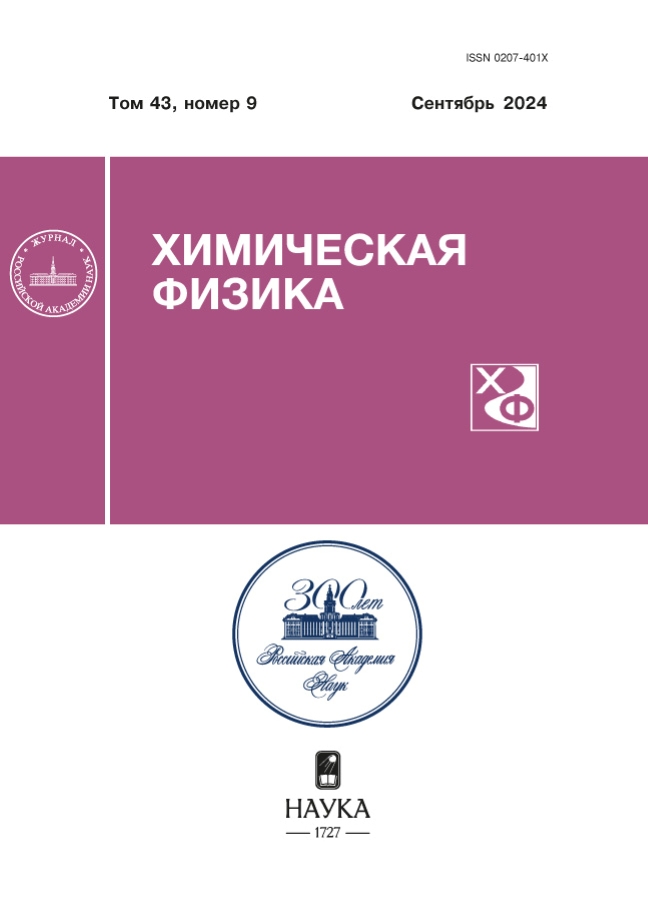Adhesion of mold spores to polymer materials during their deposition in the air
- 作者: Kalinina I.G.1, Ivanov V.B.1, Semenov S.A.1, Kazarin V.V.1, Zhdanova O.A.1
-
隶属关系:
- Federal state budgetary institution of science Federal research center of chemical physics N. N. Semenova Russian Academy of Sciences (FIC CHF N.N. Semenov RAS)
- 期: 卷 43, 编号 9 (2024)
- 页面: 69-74
- 栏目: Chemical physics of biological processes
- URL: https://medjrf.com/0207-401X/article/view/680968
- DOI: https://doi.org/10.31857/S0207401X24090085
- ID: 680968
如何引用文章
详细
The features of the adhesive interaction of spores of various types of mold fungi deposited in a stationary air environment with polymeric materials are investigated. It is shown that regardless of the type of material, its angle of inclination and the type of fungus, all spores that have reached the polymer surface remain on it. The location of the sample relative to the source of spore propagation and the mechanism of their supply to the surface determine the number of spores retained on the material, characterizing the microbiological component of the air environment (the content and specific consumption of fungal spores in it). An algorithm for estimating this characteristic is proposed. It is advisable to take the research results into account when developing methods for testing the resistance of polymer materials to infection and damage by biodegradable fungi.
全文:
作者简介
I. Kalinina
Federal state budgetary institution of science Federal research center of chemical physics N. N. Semenova Russian Academy of Sciences (FIC CHF N.N. Semenov RAS)
编辑信件的主要联系方式.
Email: i_kalinina1950@mail.ru
俄罗斯联邦, Moscow
V. Ivanov
Federal state budgetary institution of science Federal research center of chemical physics N. N. Semenova Russian Academy of Sciences (FIC CHF N.N. Semenov RAS)
Email: i_kalinina1950@mail.ru
俄罗斯联邦, Moscow
S. Semenov
Federal state budgetary institution of science Federal research center of chemical physics N. N. Semenova Russian Academy of Sciences (FIC CHF N.N. Semenov RAS)
Email: i_kalinina1950@mail.ru
俄罗斯联邦, Moscow
V. Kazarin
Federal state budgetary institution of science Federal research center of chemical physics N. N. Semenova Russian Academy of Sciences (FIC CHF N.N. Semenov RAS)
Email: i_kalinina1950@mail.ru
俄罗斯联邦, Moscow
O. Zhdanova
Federal state budgetary institution of science Federal research center of chemical physics N. N. Semenova Russian Academy of Sciences (FIC CHF N.N. Semenov RAS)
Email: i_kalinina1950@mail.ru
俄罗斯联邦, Moscow
参考
- B.K.H. Lim, and E.S. Thian, Sci. Total Environ. 20, 813 (2022). http://doi.org/10.16|j.scitotenv.2021.151880
- I.G. Kalinina, G.P. Belov, K.Z. Gumargalieva, and Yu.S. Petronyuk, Russ. J. Phys. Chem. B, 5, 139 (2011). http://doi.org/10.1134/S1990793111020047
- B.C. Daglen, and D.R. Tyler, Green Chem Lett. Rev. 3. 69 (2010). https://doi.org/10.1080/17518250903506723
- W. Abdelmoez, I. Dahab, E.M. Ragab, O.A. Abbdelsalam, O.A. Mustafa, and A. Mustafa, Polym. Adv. Technol. 32, 1981 (2021). https://doi.org/10.1002/pat.5253
- I.G. Kalinina, S.A. Semenov, and V.B. Ivanov, Ros. Khim. Zh. 68, 9 (2024). http://doi.org/10.60601RCI. 202024681.2
- T.A. Camesano, Y. Liu, and M. Datta, Adv. Water Res.. 30. 1470. (2007). http://doi.org/10.1016/j.advwatres.2006.05.023
- R. Burgers, S. Hahnel, T. E. Reichert, M. Rosentritt, M. Behr, T. Gerlach, G. Handel, and M. Gosau, Acta Biomater. 6, 2307 (2010). http://dx.doi.org110.1016/jactbio.2009.11.003
- V.K. Vivi, S.M. Martins-Franchetti, and D. Attili-Angelis, Folia Microbiol. 64, 1 (2019). http://doi.org/10.1007/s12223-018-0621-4
- B.-E. Priegnitz, A. Wargenau, U. Brandt, M. Rohde, S. Dietrich, A. Kwade, R. Krull, and A. Fleissner, Fungal Gen. Biol. 49, 30 (2012). http://doi.org/10.1016/j.fgb.2011.12.002
- Y. Shen, M. Nakajima, M.R. Ahmad, S. Kojima, M. Hommac, T. Fukuda, Ultramicroscopy. 111. 1176 (2011). http://doi.org/10.1016/j.ultramic.2011.02.008
- I.G. Kalinina, K.Z. Gumargalieva, V.V. Kazarin, and S.A. Semenov, Russ. J. Phys. Chem. B 11, 304 (2017). http://doi.org/10.1134/S19907931170200463
- I.G. Kalinina, K.Z. Gumargalieva, S.A. Semenov, and V.V. Kazarin, Russ. J. Phys. Chem. B 12, 135 (2018). https://doi.org/10.1134/S1990793118010189
- I.G. Kalinina, V.B. Ivanov, S.A.Semenov, V.V. Kazarin, and O.A. Zhdanova, Russ. J. Phys. Chem. B 15, 506 (2021). https://doi.org/10.1134/S1990793121030210
- K.A. Whitehead, T. Deisenroth, A. Preuss, and Ch.M. Liauw, J. Verran, Coll. Surf. B: Biointerfaces. 82, 483 (2011). https://doi.org/10.1016/j.colsurfb.2010.10.001
- I.G. Kalinina, V.B Ivanov, S.A. Semenov, V.V. Kazarin, and O.A. Zhdanova, Russ. J. Phys. Chem. B 17, 78 (2023). https://doi.org/10.31857/S0207401X23020085
- I.G. Kalinina, V.B Ivanov, S.A. Semenov, V.V. Kazarin, and O.A. Zhdanova, Russ. J. Phys. Chem. B 14, 1014 (2020). https://doi.org/10.1134 /S1990793120060068
- I.G. Kalinina, and K.Z. Gumargalieva, Prot. Metals Phys. Chem. Surf. 50, 910 (2014). https://doi.org/10.1134/S2070205114070089
- X. Li, T. Zhang, and S. Wang, Indoor Air. 28, 744 (2018). https://doi.org/10.1111/ina.12486
- A. Wargenau, and A. Kwade, Langmuir. 26, 11071 (2010). https://doi.org/10.1021/la100653c
- C.L.C. Tan, S. Gao, B.S. Wee, A. Asa-Awuku, and B.J.R. Thio. Aerosol Sci. Technol.. 48, 541 (2014). https://doi.org/10.1080/02786826.2014.898835
- E. Levetin and K. Dorsey, Aerobiologia, 22, 3 (2006). https://doi.org/10.1007/s10453-005-9012-9
- I.G. Kalinina, V.B. Ivanov, S.A. Semenov, V.V. Kazarin, and O.A. Zhdanova. Russ. J. Phys. Chem. B 123 (2022). https://doi.org/10.1134/S1990793122010213
- GOST 9.048-89. ESZKS. Technical products. Methods of laboratory tests for resistance to mold fungi. http://www.gostexpert.ru/gost/gost-9.048-89/
- GOST 9.049-91. Materials polymeric and their components. Methods of laboratory tests for resistance to mold fungi. http://www.gostexpert.ru/gost/gost-9.049-91/
补充文件










